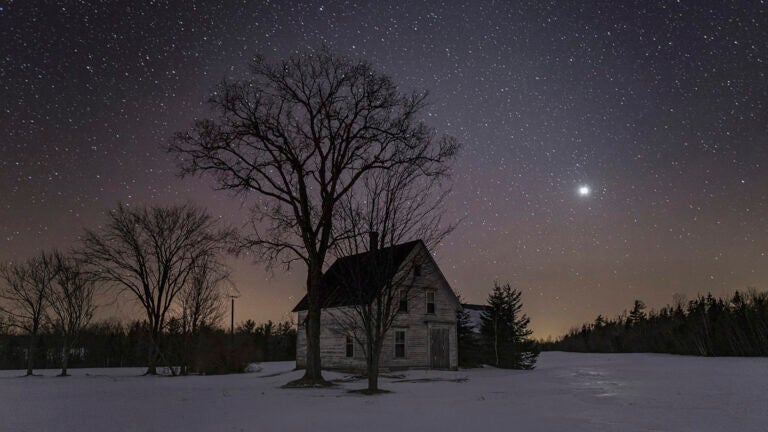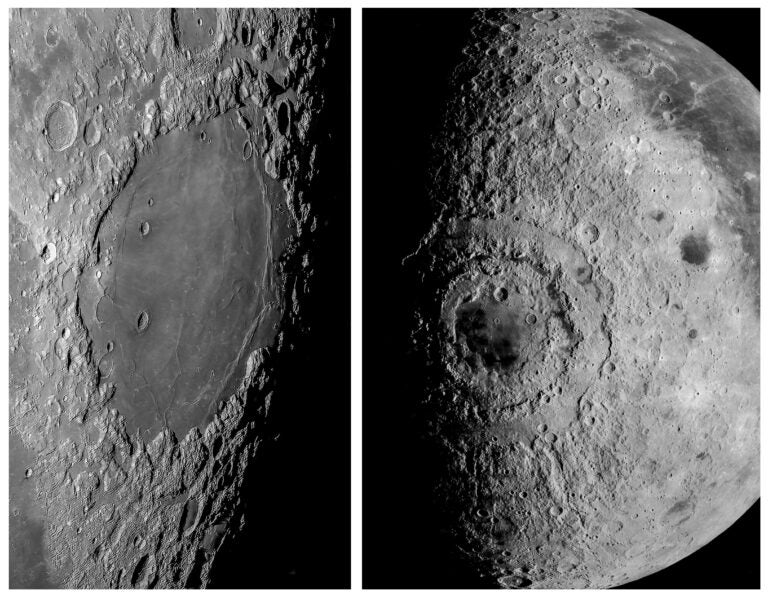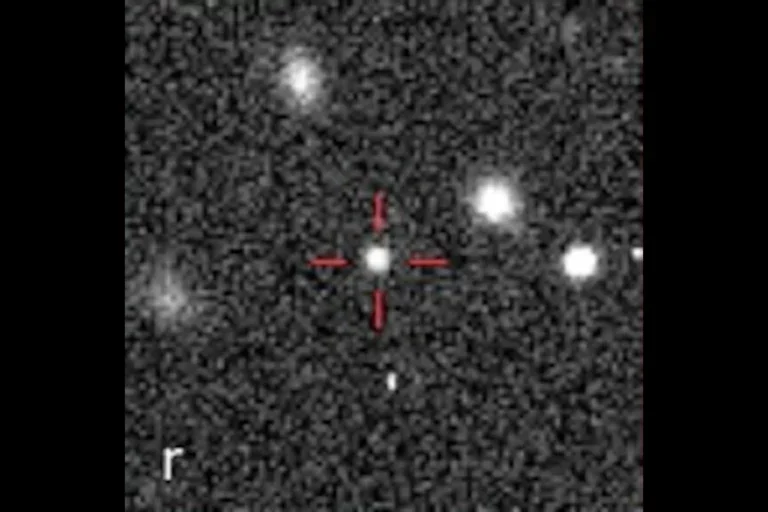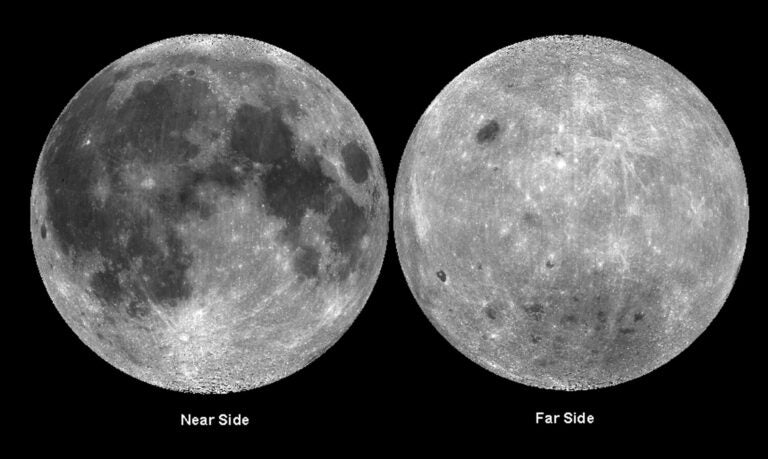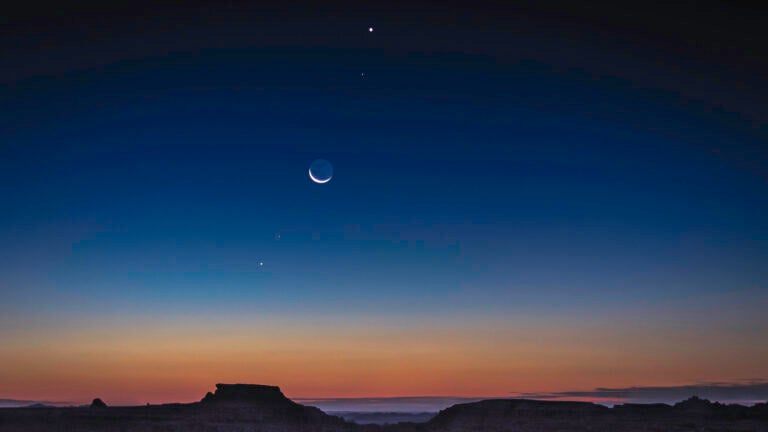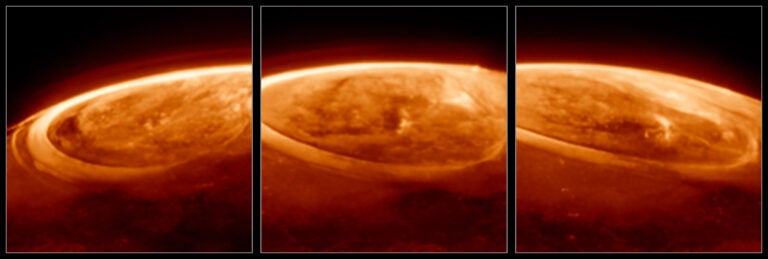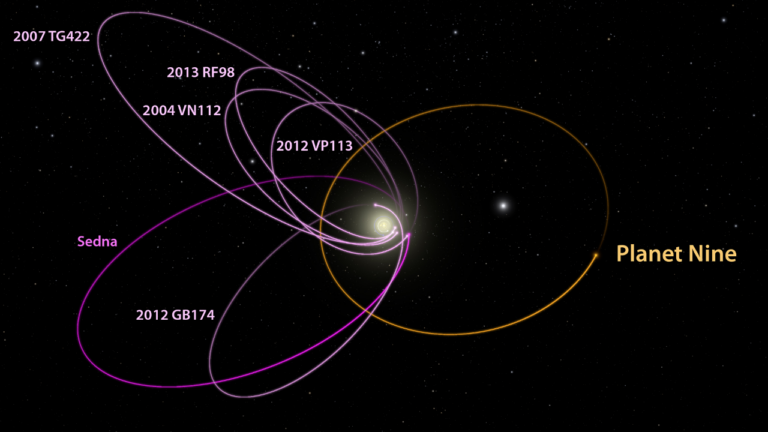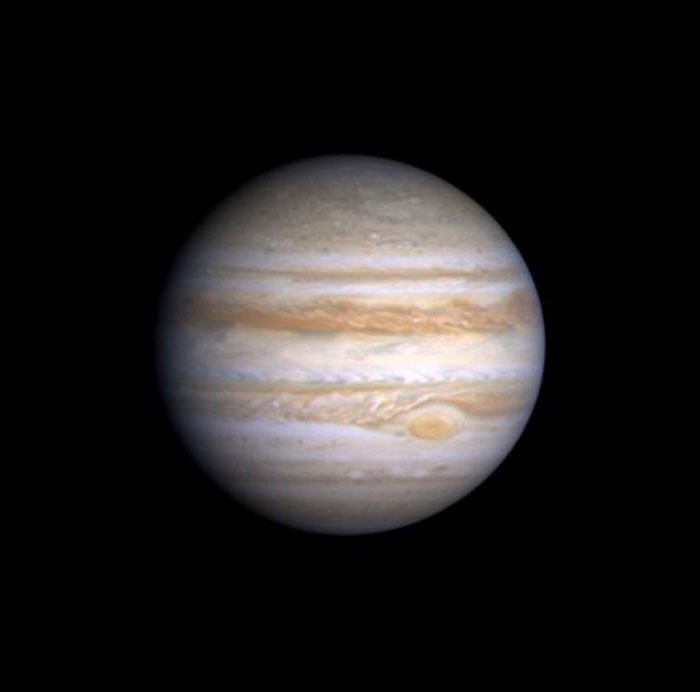

Jupiter reaches opposition and best visibility in early February, when it looms largest through a telescope. Expect to see an alternating series of bright zones and darker belts in the planet’s atmosphere.
NASA/ESA/A. Simon (GSFC)
Venus dazzles in the western sky after sunset, a beacon you won’t mistake for any other celestial object. It makes a pretty pair with Mars all month, though the Red Planet pales in comparison to its brilliant neighbor. A crescent Moon adds luster to the scene February 20.
As Venus dips low in the west, Jupiter climbs farther above the opposite horizon. The giant planet reaches its peak this month and will be a telescopic delight, displaying intricate cloud features and dancing moons from dusk to dawn. Closing out the long February nights, Saturn makes a nice addition to the stars of northern Scorpius.
Winter evenings arrive suddenly in February — temperatures plummet, and the snow that melts from rooftops during daylight turns into icicles. Shining like a huge ice crystal catching the last rays of the Sun, Venus hangs in the western twilight sky all month. It gleams at magnitude –3.9, making it the sky’s brightest point of light. Swing a telescope toward the “evening star” early in the month, and you’ll see its nearly round 11″-diameter disk.
On February 1, observers with clear skies might be able to spot Neptune just 1° northwest (to the right) of Venus. It’s a challenge to see the 8th-magnitude eighth planet through a telescope during twilight. And, unfortunately, Neptune sinks quickly into the horizon haze as the sky grows darker.
A much better conjunction adorns the western sky February 20. Venus and Mars then appear 0.7° apart, and a two-day-old crescent Moon stands some 2° away. Binoculars and rich-field telescopes at low power will deliver spectacular views of the trio.
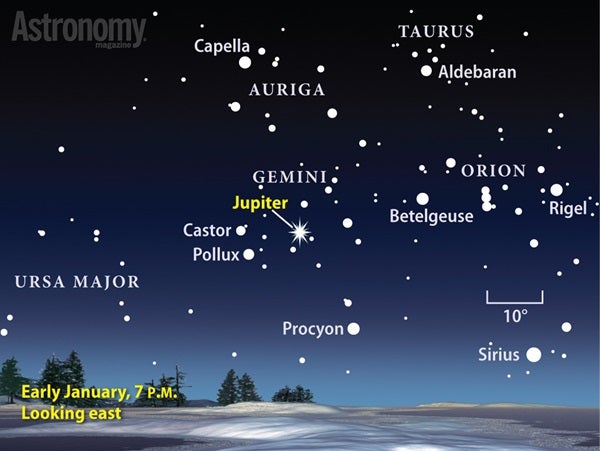
Jupiter lies among the relatively faint background stars of Cancer the Crab at its February peak.
All illustrations: Astronomy: Roen Kelly
The Moon appears 6 percent lit and contrasts nicely with Venus’ slimmed-down, 88-percent-lit gibbous phase. The Sun fully illuminates Mars, which lies on the far side of our star beyond Venus, and its 4″-diameter disk shines at magnitude 1.3.
The following evening, February 21, Venus and Mars pass within 26′ of each other. The Moon then stands 14° above the planets and still shows a slender crescent phase. Look through binoculars or a telescope 1° to our satellite’s west (off its sunlit limb), and you’ll see the 6th-magnitude glow of Uranus. A telescope quickly confirms its planetary nature by showing a blue-green disk that spans 3.4″.
Venus, Mars, and Uranus all lie among the background stars of Pisces the Fish during February’s final 10 days. On the 28th, the three stretch along a 7.5° arc of the ecliptic — the Sun’s apparent path across the sky that the planets follow closely. Venus stands approximately midway between the fainter pair.
To find the next planet, you have to scan along the ecliptic all the way through Aries, Taurus, and Gemini before finally settling in Cancer. Jupiter dominates this constellation’s faint stellar backdrop and, indeed, the rest of the night sky after Venus sets around 8 p.m. local time. The giant planet reaches opposition February 6, when it shines at magnitude –2.6. Three days prior to opposition (on the night of February 3/4), a Full Moon passes 5° south of the planet.The gaseous world also appears largest through a telescope at opposition, with its equatorial girth spanning 45.4″. February offers observers their best views of jovian atmospheric features during 2015. And the long winter nights mean you can track or image the planet through one complete rotation, which takes slightly less than 10 hours, during complete darkness.
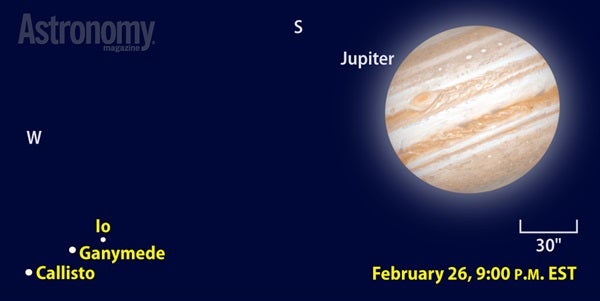
Three jovian moons lie near one another the night of February 26/27. Between 9 p.m. and 3 a.m., four mutual events take place among them.
Sharp views of Jupiter’s distant atmosphere ironically depend on the stability of Earth’s atmosphere. Steady seeing develops when turbulence in the air above your head dies down. These precious moments might last a few seconds or, on exquisite nights, much longer.
A quick check of Jupiter’s two dark equatorial belts will tell you what your local seeing conditions are like. If you see mottled detail and occasional dark spots with fine detail along the belts’ edges, this tells you it’s a perfect night. If not, don’t head inside. Wait a while and watch for fleeting moments of steadiness.Once you’ve had your fill of the world’s delightful atmosphere, turn your attention to the four bright Galilean satellites. Io, Europa, Ganymede, and Callisto (in order of increasing distance from Jupiter) slide back and forth as they follow their paths around the planet. Although all four rarely line up by distance, they manage this feat on the night of opposition. From sundown until around 2 a.m. EST, you can identify the moons simply by noting how far east of Jupiter they lie.
Each satellite and its shadow cross the jovian disk every circuit and then, half an orbit later, disappear behind the giant planet. Such incidents go on like clockwork every month of every year. But this year something even more spectacular occurs. The orbits of the Galilean satellites now appear nearly edge-on to both the Sun and Earth, initiating a series of so-called mutual events. You can watch as one moon passes in front of another (an occultation) or one moon passes through another’s shadow (an eclipse). A few dozen such events occur during February for observers in the United States and Canada.
Most mutual eclipses and occultations occur alone and last for only a few minutes. On the North American night of February 26/27, however, four events involving Io, Ganymede, and Callisto happen over a six-hour period. The series begins with Io occulting Ganymede. The event starts at 9:17 p.m. EST and runs until 9:24 p.m. The same two moons reclaim center stage when Io’s shadow envelops Ganymede’s disk for nearly 10 minutes commencing at 10:31 p.m. Observers will see the solar system’s largest moon dim noticeably around mideclipse.
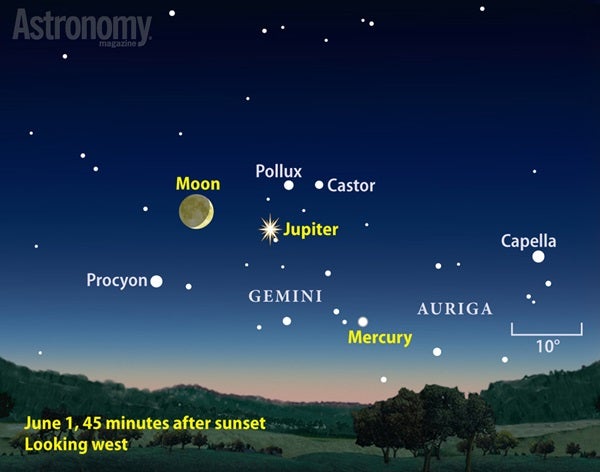
The evening of February 20 provides observers with a stunning view of a waxing crescent Moon next to Venus and Mars.
Nearly an hour later, at 11:28 p.m., Callisto eclipses Ganymede for 11 minutes. The night’s final mutual event starts at 2:49 a.m. when Callisto’s shadow sweeps across Io to initiate a 12-minute eclipse. All three moons lie well west of Jupiter during these encounters, while lonely Europa appears east of the planet as soon as it exits Jupiter’s shadow at 10:23 p.m. Such alignments of the Galilean moons beautifully illustrate their motions and allow observers to appreciate the three-dimensional nature of their orbits.
Although February nights can be cold, a hint of summer lurks in the early morning sky. The bright stars of Scorpius remind us that warmer days lie just a few months ahead. The Scorpion looks different this year, however, with bright Saturn crossing its northern flank. The solar system interloper lies 9° northwest of the constellation’s brightest star, Antares, on February 1. Both appear prominent in the southeast by 4 a.m. local time.
The planet glows at magnitude 0.5 and sports a yellowish hue that contrasts nicely with the slightly fainter star’s distinctive orange-red color. By month’s end, the pair stands well clear of the horizon by 2 a.m. Saturn then lies 0.4° due north of magnitude 4.1 Nu (ν) Scorpii.
The Last Quarter Moon on February 12 points the way to Saturn, which lies 7° to our satellite’s lower left. On the following morning, the waning crescent Moon has moved to a position 6° to the ringed planet’s lower left. Swing a telescope toward Saturn on the 13th, and you’ll find its own moon, Titan, due north of the planet. Although Titan is 50 percent bigger than our Moon, at its great distance it appears as a mere 8th-magnitude point of light.
The best time to observe Saturn through a telescope is when it climbs higher in the sky around the break of dawn. This lessens the effects of atmospheric turbulence and affords steady views of the planet and rings. In mid-February, the globe appears 17″ across while the ring system spans 38″ and tilts 25° to our line of sight. You should have no trouble seeing the dark Cassini Division that separates the outer A ring from the brighter B ring. Saturn will grow increasingly impressive as it approaches opposition this spring.
Our final planet seems like an afterthought in comparison with the delights of Venus, Jupiter, and Saturn. Mercury reaches greatest elongation February 24, when it lies 27° west of the Sun. From mid-northern latitudes, however, it climbs just 4° above the southeastern horizon 45 minutes before sunrise. You’ll likely need binoculars to pick the magnitude 0.0 object out of the twilight glow.
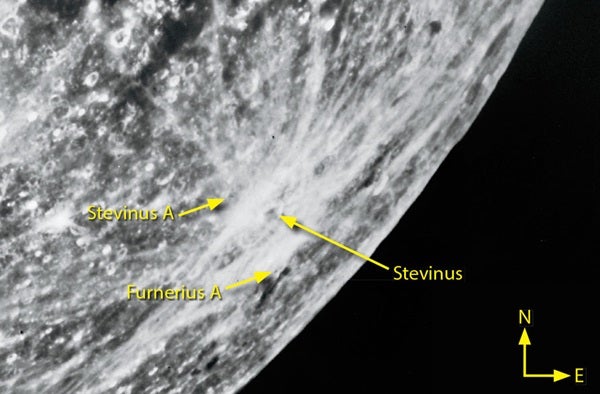
Although Tycho boasts the most famous lunar ray system, Stevinus and its neighbors also put on a splashy show at Full Moon.
Consolidated Lunar Atlas/UA/LPL
SPLASHY RAYS DELIVER A FULL MOON TREAT
Although many observers pack their scopes away at Full Moon, the completely lit orb offers an appeal of its own. The most conspicuous features are the bright rays that emanate from some of the youngest lunar craters.
While nothing compares to Tycho’s sweeping rays, a handful of other sprays will grab your attention if you let your eye roam. Look for a chaotic blotch of white material near the Moon’s southeastern limb. You’ll see lots of rays that trace back to their birth craters: Stevinus, Stevinus A, and Furnerius A.
The two smaller craters here (those with the “A”) are the youngest. Spiky rays and bright ejecta blankets surround each. They stand out until February 4 and again after the 25th. Once the Sun dips lower in the lunar sky after Full phase, albedo features become lost among the countless shadows cast by crater rims and peaks.
Now focus your attention on Mare Nectaris, which lies northwest of our highlighted region. One of Tycho’s brightest rays crosses this sea from southwest to northeast. Look more carefully, however, and you’ll see a less conspicuous white line that cuts at right angles to this one and points back to Stevinus.
Lunar rays appear bright for two reasons. First, they form from excavated highland material, which is naturally lighter than volcanic mare deposits. Second, constant bombardment by atoms in the solar wind slowly darkens the lunar surface over time, making older regions less reflective.
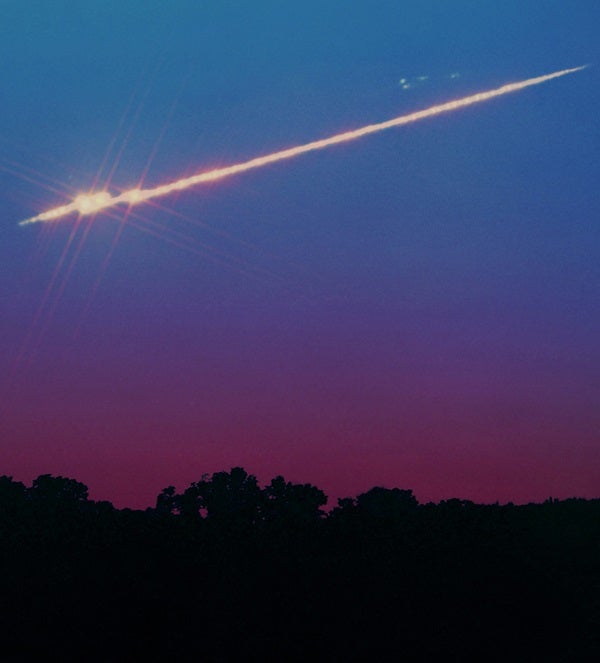
Brilliant fireballs and exploding bolides can put a charge into February’s otherwise lackluster meteor calendar.
John Chumack
SPORADICS BEAT BACK THE METEOR DOLDRUMS
If the names “Beta Herculids” and “Delta Serpentids” don’t ring a bell, don’t fret — they are about as inconsequential as meteor showers can get. Each delivers at most one meteor per hour, on average, yet they rank as the best of February’s annual events for Northern Hemisphere observers.
In this quiet meteor month, your best bet is to keep an eye out for sporadics. Astronomers think these random “shooting stars” derive from ancient periodic comets whose dust streams thinned out long ago. Under the dark morning skies that prevail after midmonth, you should see about six sporadics per hour. If you’re lucky, you’ll spot a fireball (one brighter than Venus) or a bolide (one that explodes at the end of its path).
| WHEN TO VIEW THE PLANETS | ||
| Evening Sky | Midnight | Morning Sky |
| Venus (west) | Jupiter (south) | Mercury (southeast) |
| Mars (west) | Jupiter (west) | |
| Jupiter (east) | Saturn (south) | |
| Uranus (southwest) | ||
| Neptune (west) | ||
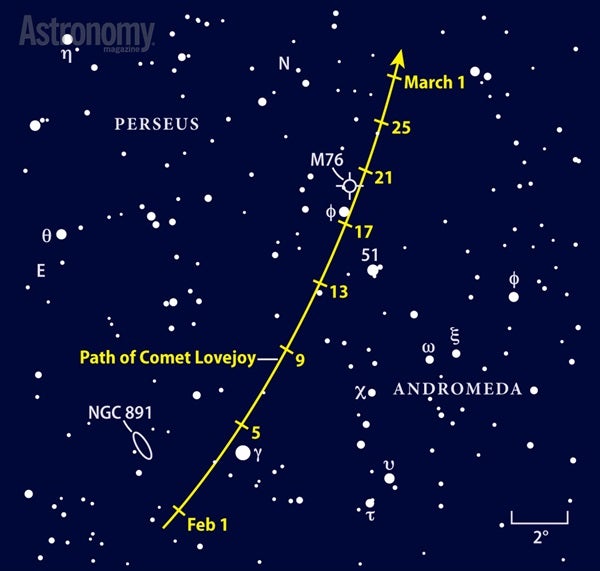
This first-time visitor to the inner solar system slides past the edge-on galaxy NGC 891 and the planetary nebula M76 during February.
ARCING BETWEEN THE PRINCESS AND THE HERO
Comet Lovejoy (C/2014 Q2) makes a welcome addition to the stars and other deep-sky objects nestled along the winter Milky Way in Andromeda the Princess and Perseus the Hero. Even better, the region is perfectly placed in the northwest on February evenings.
Lovejoy has some notable encounters with background objects this month. On February 4, it passes less than 1° east of the lovely 2nd-magnitude double star Gamma (γ) Andromedae and 3° west of the spectacular edge-on spiral galaxy NGC 891. Lovejoy should glow at 8th or 9th magnitude, making it brighter than NGC 891. Unfortunately, the nearly Full Moon will hinder views of both comet and galaxy.
But the Moon will be out of the way for Lovejoy’s next series of close encounters. On February 18, the comet passes less than 0.5° west of 4th-magnitude Phi (ϕ) Persei. Two days later, it skims a similar distance west of the Little Dumbbell Nebula (M76). Both Lovejoy and M76 benefit from views at medium to high power. Neither appears round, and each has some well-defined edges. Lovejoy’s sharp boundary is on its southwestern edge, where the solar wind blows the comet’s ionized gas straight out from the coma.
Australian amateur astronomer Terry Lovejoy discovered this dirty snowball August 17, 2014. It currently lies between the orbits of Earth and Mars, close enough to the Sun’s warming influence to put on a decent show. C/2014 Q2 hails from the distant Oort Cloud, a vast reservoir at the solar system’s edge filled with a trillion or so frozen comet nuclei. With the notable exception of Comet 1P/Halley, short-period comets (those that orbit the Sun in less than 200 years) don’t provide observers with months of exciting viewing. Luckily, the Oort Cloud delivers dozens of fresh comets to the inner solar system each year, and two or three typically grow bright enough to make good targets for small scopes.
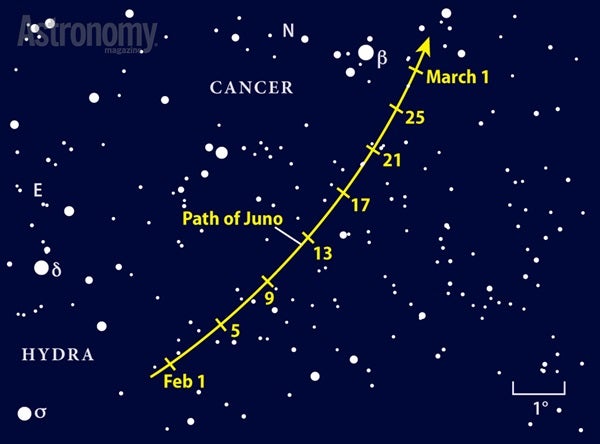
Asteroid Juno dims from 8th to 9th magnitude as it makes its way northwestward across the faint backdrop of Hydra and Cancer.
CRAWLING THROUGH THE CRAB
Our minor planet target this month is a potato-shaped rock spanning some 170 miles. Asteroid 3 Juno lies approximately halfway between the beacons of nearby Jupiter and distant Procyon, a region that climbs high in the southeast by 9 p.m. local time. The 8th-magnitude asteroid crosses from Hydra the Water Snake into Cancer the Crab in mid-February. Wait until February 5 for the bright Moon to take its leave from this part of the sky.
While you’re in the area, make brief detours to two of the Crab’s deep-sky gems. The Beehive star cluster (M44) stands in central Cancer and ranks high on most observers’ lists. Binoculars and rich-field telescopes best show this treat. Another great open star cluster, M67, is a pretty sight through any telescope. It lies 8° south-southeast of M44.
If you’re new to asteroid hunting and want the easiest path to success, wait until the end of February, when Juno appears 1° southwest of magnitude 3.5 Beta (β) Cancri. None of the other background stars in this vicinity outshines Juno.
Or you can join those who discover by motion. Jump about 1.5° south of Beta to a quadrilateral of four stars, and sketch their positions. On February 22, Juno sits inside this stellar group. To see the main-belt object shift position during one observing session, pick it up in early evening and then return to the area three or four hours later.
Martin Ratcliffe provides planetarium development for Sky-Skan, Inc. from his home in Wichita, Kansas. Meteorologist Alister Ling works for Environment Canada in Edmonton, Alberta.


